MDA20009 Learning Group 02 Assignment 1: Blog Irene Phillips
Don't wanna be here? Send us removal request.
Quote
Needing to have reality confirmed and experience enhanced by photographs is an aesthetic consumerism to which everyone is now addicted.
On Photography, Susan Sontag (and she wrote this in 1977!)
Yes!
2K notes
·
View notes
Photo
LOL. #dialup

This ads showing up everytime i open Pornhub. I’m here to get things done quickly, not play games that test my resistance.
1K notes
·
View notes
Video
Help Us ALL, when these two minds collide!!
tumblr
Kim Kardashian West arrives at White House, where she will reportedly participate in meetings on prison reform.
51 notes
·
View notes
Text
NRA: “Any teenager who peacefully protests school shootings are ‘Civil’ terrorists.” GOP: “Black men protesting peacefully during the national anthem is disrespectful and they should be punished.”
This isn’t even fascism creeping in quietly, which according to history classes, fascism tends to do.
No, this is fascism being all “HEY, GUYS. I AM TOTALLY HERE. AND AREN’T I COOL?”
Fascism ain’t even being sneaky anymore.
640 notes
·
View notes
Photo
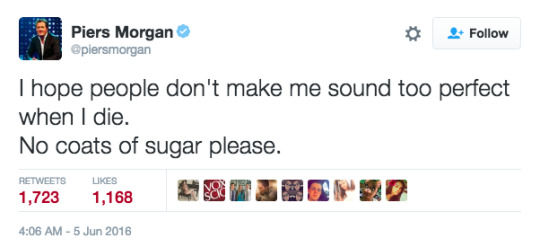



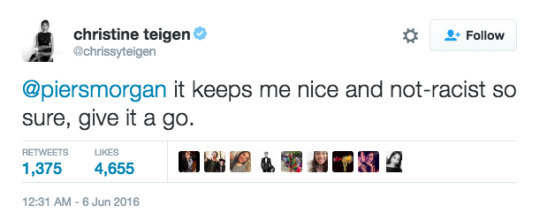

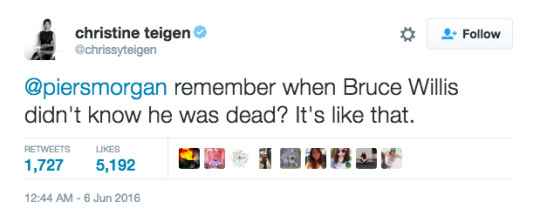

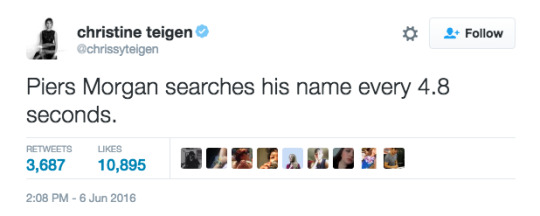

Chrissy Teigen is trolling Piers Morgan with the most delicious intensity right now
84K notes
·
View notes
Text
#Week 5 Digital Citizenship: Political Engagement

Social media has transformed the landscape of politics we learnt as week 5 brought discussion of digital citizenship and political engagement. As we looked into connection between political campaigns and social media it became discernible the effectiveness of different campaigns through the uses of different social media platforms with varying approaches.
Digital Citizenship facilitates ‘the membership and participation of individuals within a society’ (Mossberger et al. 2008:1). When the digital landscape is intertwined political engagement it enables politicians to amplify and control their messages while being able to communicate to a younger and larger audience.
The effectiveness of social media during election campaigns are addressed by Gunn Enli (p. 51, 2017) who asserts the 3 main strands including ‘historical development of digital campaigns’ (p. 51), interaction with voters and professionalism of campaigns. He noted that voters have been mobilized with the rise of new social media platforms, such as Twitter, enabling a new interaction with voters. However, it can be challenging to maintain professionalism of campaigns through social media.
While Obama paved the path for emphasizing election campaigns on social media, the 2016 US election campaigns depicted contrasting strategies between Hillary Clinton and Donald Trump. Clinton carried a structured and professional social media campaign that was completed through conventional, polite and formal techniques. In opposition Trump’s campaign was accomplished with a more amateur and unprofessionally authentic persona. In which his controversial remarks fueled his media exposure.
However the political landscape of social media campaigns can have negative effects. Through the very strong opinions amongst politics, it can often leave politicians in fear or these with strong opinions
Strong opinions amongst political discussion online such as through #auspol on twitter can leave politicians in fear. Through strong negative opinions, rumors, hate pages, inevitable memes and possibly even death threats social media can also be a destructive force to a political campaign. Memes are often a tool of humiliation, degrading politicians, which ‘gradually scale in a shared social phenomenon… as cultural information passes from person to person’ (Limor Shifman, 2013). Social media opinions can have a strong influence on voters.
Within these campaigns media monopolies have strong political influence. Despite the labor party trying to bring in laws to break the media monopoly in 2015, dominating with his ownership in the media, Rupert Murdoch’s holds ownership of media platforms across Australia and International media. This generates a limited diversity of opinions and views and creates a bias political coverage, while carrying such a strong political influence as trusted and reputable news sources.
Therefore political engagement through social media is an opportunity to enhance a campaign however also has the ability to be drive a campaign into an undesirable light.
Reference
Enli, G 2017, Twitter as an arena for the authentic outsider: Exploring the social media campaigns of Trump and Clinton in the 2016 presidential election, European Journal of Communication, vol 32, no 1, p 51
Shiftman, L 2013, Mit Press Essential Knowledge: Memes in Digital Culture, The MIT Press Essential Knowledge Ser, MIT Press.
Mossberger, K, Tolbert C, McNeal, Ramona S, 2008, Digital Citizenship: the Internet, Society and Participation, Cambridge Mass: MIT Press.
4 notes
·
View notes
Text
GAME ON - SOCIAL GAMING
Online gaming is entirely another world, this digital community has grown exponentially in the last 20 years. But it was the 2000’s that started the era of gaming we see today. “As the 2000s began with the dot-com bubble bursting, you might have thought tech was risky. What actually occurs is online gaming begins to do what gamers have been waiting almost 2 decades for” (Rivenes 2017)
I personally am not a gamer, the furthest I’ve gotten was on a SEGA, then Mario Kart on Nintendo and now occasionally, arcade games at a Time Zone outlet. Although I did have a phase after Facebook upped their gaming configurations of simultaneous running a farm (Farm Town), theme park (Coaster World), restaurant (Restaurant City) and cafe (Cafe World). It was exhausting being a tycoon and I soon consolidated my assets and deactivated my franchise.
A housemate of mine, on the other hand, delved right into the online gaming community, they played COD (Call of Duty) in an MMOG, had a very high ranking, headed up an all-female squad, would wake in the late afternoon to play all night tournaments, and would share stories of trolling, abuse, threats, verbal sexual taunts, racism and even more creative narcissistic behaviours in these digital communities. I always wondered why they went back, with so much harassment why continue to participate?
But my housemate was an introvert with a social anxiety disorder, and basically as Stuart (2013) describes being a part of an online community takes away traumas and inhibitions, and gamers are able to create, contribute and participate with a community that understands them. For the most part.
But who are these “games”? Here some states to clear that up; “68% of Australians play video games. 47% of video game players are female. 33 years old is the average age of video game players. 78% of players are aged 18 years or older. 39% of those aged 65 and overplay video games. 12 years is the average length of time adult players have been playing” (Brand & Todhunter 2016).

And now with smartphones, the gaming communities just keep growing, remember the Pokemon pandemic? But even as the Pokemon craze slowed gaming hasn’t, but it's not all about the players. The industry itself is peaking as “gaming has become so popular that some schools are adding professional video gaming and esports to their curricullum [sic]” (Milligan 2018)
The gaming world does not just consist of first player games, or MMOG’s, but there is also gambling communities, which are highly unregulated. Other games require you to spend real money to be able to progress in the game. There are worldwide gaming conventions as well as continuous play live gaming tournaments or E-Sports played out in “Multiplayer online battle arenas, or MOBAs” (Jensen 2015). And then there was Jon Eimer who “broke the world record for longest video game marathon on a MOBA game, coming in at 72 hours with two allocated breaks” (Bishop 0217), think about that for a minute...
As our future moves closer to becoming all online and virtual, with STEM education taking over precedence of future employment gaming communities may, in fact, be in front of the rest of us who do not participate in this lifestyle. That’s ok with me, you’ll still find me at home playing UNO with my real life community with Blade Runner in the background.

REFERENCES
Bishop, S 2017, Streamer breaks record for longest marathon on a MOBA, Gamereactor, viewed 31 May 2018, <https://www.gamereactor.eu/esports/508323/Streamer+breaks+record+for+longest+marathon+on+a+MOBA/>.
Brand, J E & Todhunter, S 2016, Digital Australia report 2016, Bond University, viewed 31 May 2018, <https://www.igea.net/wp-content/uploads/2015/07/Digital-Australia-2016-DA16-Final.pdf>.
Jensen, T 2015, The greatest gaming tournament in the world, PCmac.com, viewed 31 May 2018, <https://www.pcmag.com/feature/332886/the-greatest-gaming-tournaments-in-the-world>.
Milligan, M 2018, Gaming goes mainstream for both playing and watching, Limelight networks, viewed 31 May 2018, <https://www.limelight.com/blog/state-of-online-gaming-2018/>.
Rivenes, L 2017, The history of online gaming, Datapath.io, viewed 31 May 2018, <https://datapath.io/resources/blog/the-history-of-online-gaming/>.
Stuart, K 2013, Gamer communities: the positive side, The Guardian, viewed 31 May 2018, <https://www.theguardian.com/technology/gamesblog/2013/jul/31/gamer-communities-positive-side-twitter>.
5 notes
·
View notes
Text
Pics or it didn’t happen
Society has always been mesmerised by capturing images, since the invention of the camera in 1685 and the first photograph in 1814, this practice was once about preserving memories, through family photos albums and self-portraits. But now with ubiquitous photography, we have entered full throttle into the ‘selfie culture era’ and these images are social currency. Through this currency, we are seeing a trend where getting the image out quickly is taking over being archived, but with worldwide servers storing all our data permanently, they are still be archived, but what will the future think of us when they look back.

Although this movement receives much criticism, and rightly so because “human attention as a gift rather than an economic manifestation of capitalist value” (Lange 2009), with terms such as narcissism are being used to describe the behaviour, the interesting thing to note is social media platforms actually privilege this style of content by classifying it as desirable content that visual publics want to see more of. And with platforms like Instagram, Snapchat, Pinterest and Flickr all having a strong and growing membership rate it is easy to see why this content receives a high engagement rate.
There is also the legal side to images begin shared widely across visual platforms. Watermarks were once a safeguard to ensuring credit where credit is due, then using embedded links were used, but now, although still utilised, are mostly ineffective. If you do a simple Google search you will discover thread upon thread where photographers are battling these copyright infringements and mostly with no resolution that benefits them in sight. Check out this link to read more about photography thief.
Whether you love or hate selfies they are an important part of not only self-experience but of cultural and social changes made easier by technology. Not all selfies are self-serving, and although “posting selfies publicly inherently exposes the person to trolling and hate speech, it also connects them with a global network of potential support” (Van Houten Maldonado 2018), but only that marginalised individuals and groups are now able to share their everyday experiences creating awareness and exposure through networked visuality.

REFERENCES
Hill, Kate 2016, Stolen images: Limestone Coast photographers fighting back against online theft, ABC news, viewed 26 May 2018, <http://www.abc.net.au/news/2016-12-08/stolen-images-photographers-fight-back-against-online-theft/8102886>.
Lange, P 2009, ‘Videos of Affinity on YouTube’, in P, Snickars & P, Vonderau (eds), The YouTube Reader, National Library of Sweden, Stockholm, pp. 70-88.
Van Houten Maldonado, D 2018, Why selfies can be a force of social good, BBC, viewed 26 May 2018, <http://www.bbc.com/culture/story/20180112-why-selfies-can-be-a-force-for-social-good>.
3 notes
·
View notes
Text
Crowdsourcing - Where many minds unite.
What is crowdsourcing? As defined by Crowdsourcing Week (2018) it “is the practice of engaging a ‘crowd’ or group for a common goal — often innovation, problem-solving, or efficiency”.
The term was coined by “Jeff Howe, a contributing editor to Wired magazine” who “first coined the term "crowdsourcing" in a June 2006 article” (Alserver 2018).
Although the idea is not new and has been previously used throughout history, for example “in 1884, the Oxford English Dictionary relied upon 800 readers to catalog [sic] words” (Chrum 2013), the fact that technology is so accessible and can now integrate with other platforms is seeing this method of information gathering and sharing richly effective.

Platforms that are common for their crowdsourcing capabilities are; Wikipedia, Ushahidi, Upwork, Startsomegood, to name a few. Each of these platforms has varying uses and are not limited to crowdsourcing for social change. Upwork, which was called oDesk is a prime example, this site connects professionals in need of tech work done, to freelancers. You simple most a job, users bid and you choose who you would like to hire, this service is a fraction of the price of hiring a tech freelancer in person, and they could be based anywhere in the world because geography is no longer a barrier.
The platform Ushahidi is an interesting example of crowdsourcing for social change, created in 2007 during the Kenyan presidential election, the platform was created to let people know of the human rights violations occurring due to restrictions being placed on the media. “Originally a collaboration between Kenyan and international citizen journalists and software developers” (Ford 2012) Ushahidi has now evolved so that anyone can create crowd-mapping with the public able to contribute to the reports of a crisis.
With 7 billion people on the planet all with different cultural experiences, individual skills and life perceptions, coupled with the rise of connectedness due to technological advancements, crowdsourcing is here to stay and will see a future that creates social change, innovates ideas and changes business practices coming from many minds from all over the global, to unite all.

REFERENCES
Alsever, E 2008, What is crowdsourcing, CBSnews, viewed 26 May 2018, <https://www.cbsnews.com/news/what-is-crowdsourcing/>.
Chrum, A 2013, The Long History of Crowdsourcing - and Why You're Just Now Hearing About It, Crowdsource - a onespace company, viewed 26 May 2018. <https://www.crowdsource.com/blog/2013/08/the-long-history-of-crowdsourcing-and-why-youre-just-now-hearing-about-it/>.
Crowdsourcing week, 2018, What is crowdsourcing, Crowdsourcingweek.com, viewed 26 May 2018, <https://crowdsourcingweek.com/what-is-crowdsourcing/>.
Ford, H 2012, 'Crowd Wisdom', Index on Censorship, vol. 41, no. 4, pp. 33-39.
5 notes
·
View notes
Text
To (delete-report-block) Troll, or not to (delete-report-block) Troll, that is the question?
In 2018 I'm one of the blessed citizens within a digital community who actively participates on social media sites that have not been trolled, and if I have, it has been unmemorable. But, I am a cautious user also, I have Twitter, Facebook, Instagram and LinkedIn accounts (active) and have multiple other socials accounts which are mostly dormant. I use forums for professional use only and all of them are nurturing, inclusive and educational, I am also well past my high school years (thankfully). In this day and age, I feel tremendous anxiety for teens as not only are they navigating self-discovery, their placement within a community, but have to contend with online interactions as well.
With all of this swirling around in their pubescence heads they then endeavour to cope with online trolling and cyberbullying behaviours also and sometimes participate in (frenemies anyone?). 67% of trolling victims are American young adults aged between 18 to 29 years of age (Duggan 2017), but Interesting Boyd noted teens do not look at trolling or bullying the same way as adults, after much research she found teens label most of these behaviours as 'dramas' instead (Boyd 2014).

Is this perhaps because they have grown up in a time where this is a common expectation of navigating adolescence, therefore under-play the intentions. Either way, Internet trolling has now become an epidemic with many celebrities and politicians closing their Twitter accounts to remove themselves from being victimised. The anonymity the Internet offers from consequences is obvious, as government bodies are now ever evolving their policies on online harassment and the term “just trolling” is commonplace and has begun to promote a “normalises hate and encourage an unlikely social dystopia defined by an idol, ironic, detachment arrived at the terms of the harnesser” (PBS 2016). This sentence is scary but true. To delve further into this statement click here to view PBS's Youtube video on the subject.
But it is not only young adults affect, Donald Trump is renowned for promoting his followers into trolling his adversaries and has been said to have' “indirectly got his Twitter followers to attack GOP political strategist Cheri Jacobus so severely that her lawyers sent him a cease-and-desist order” (Stein 2016). So how do we eradicate this behaviour if the leader of the free world is promoting it?
Sarah Silverman could answer that question. Silverman was recently trolled on Twitter and instead of evoking her inner soap-box, she responded with kindness, “I believe in you. I read ur [sic] timeline & I see what ur [sic] doing & your rage is thinly veiled pain” (Klein 2018). Bravo to her in leading the charge rendering this troll powerless.

Although there is still the ability to remain anonymous, especially on Twitter. To simply log-on, troll, log-off and forget damages done, it will not remain so as there is a big push for legislative changes and the spotlight is on. The time of the troll is coming to an end, and as Bob Dylan said in 1964 'The Times They Are A-Changin' (54321p 2013). Trollers Beware.
youtube
REFERENCES
Boyd, D 2014, 'Bullying: Is the Media Amplifying Meanness and Cruelty?', in It’s Complicated: The Social Lives of Networked Teens, Yale University Press, New Haven, USA, pp. 128-52.
Duggan M, 2017, Online Harassment 2017, Pew Research Centre, viewed 29 April 2018, <http://www.pewinternet.org/2017/07/11/online-harassment-2017/>.
Klein A, 2018, A Sexist Troll Attacked Sarah Silverman. She Responded By Helping Him With His Problems, The Washinton Post, viewed 29 April 2018, <https://www.washingtonpost.com/news/inspired-life/wp/2018/01/08/a-man-trolled-sarah-silverman-on-twitter-she-ended-up-helping-him-with-his-medical-problems/?noredirect=on&utm_term=.a5ad7e87915d>.
PBS Idea Channel 2016, When Is A Troll No Longer A Troll, 21 September, viewed 29 April 2018 <https://www.youtube.com/watch?v=x69Y61ThyV0>.
Stein J, 2016, How Trolls Are Ruining the Internet, Time, viewed 29 April 2018, <http://time.com/4457110/internet-trolls/>.
54321p 2013, The Times They Are A Changin, 27 December, viewed 29 April 2018, <https://www.youtube.com/watch?v=e7qQ6_RV4VQ>.
2 notes
·
View notes
Text
Active Slacktivism
Social media platforms are a powerful tool for sending information into the world, whether this information is cat videos or the last disappointing move of our government into ceasing #liveexports, the use of platforms help the message spread. But how quickly do people ‘like’, forget and move onto the next trend?
We all remember the #icebucketchallenge, which originated to raise money for ALS research, but by the end of the campaigns run digital citizens were simply dumping ice cold water over their heads for fun. And so, the judge’s are still out as to how effective social media is for real results from these call to actions. The one thing this type of activism does is document social changes and attitudes for future research. But you can click here for some examples of where Internet activism was successful.
When it comes to social changes there is a general mentality of ‘what can I do, I’m only one person!’ and this is understandable as we are bombarded with information about our world’s dysfunctionality. Which is how I felt, recently though I have now signed up to be a member of two charities whose work I wholeheartedly support. This action came from a place of wanting change and not being able to actually participate in promoting change, so I decided to support the people out in the field the only way I could.
So rather than only signing online petitions, sharing posts on Facebook and sending letters to my governmental bodies like a ‘clickitivst’ or ‘slacktivist’; which is defined as “the practice of supporting a political or social cause by means such as social media or online petitions, characterized as involving very little effort or commitment” (English Oxford Dictionary 2018), I decided to help in a more direct way, with monthly donations.
But there are cases where social media has managed to galvanise the publics, during the ‘Arab Springs’ protests, which began in 2010 and became a series of protest through the Middle East Facebook was used to educated people and created groups. Twitter notified publics in real time of changes, dangers and the situation at large, and Youtube showed the evidence of the activism. Gerbaudo (2012, p.1) called this the “contemporary protest experience”.
And after being on the ground during several protest worldwide Gerbaudo (2012, p.1) also wondered “and did all this tweeting and re-tweeting really matter when it came to influencing collective action, mobilising and coordinating people on the ground?.” He may be right, as “social media provide the tools for organized dissent yet can constrain collective action” (Youmans & York, 2012 p.316), but not only that Youman and York (2012, p.316) also recognise these platforms are looking to boost revenue, find new markets and increase users by providing a positive experience. Even though they ultimately are a business within a public domain they do strive to provide “a variety of affordances that were important at different times” (Youmans & York 2012, p. 317).

But what about Culture Jamming as a form of activism? Noted cultural jammers are Banksy and Adbusters who have taken everyday adverts, promotions and billboards, redesigned them to draw back the curtain of hypocrisy within the advertising industry. Click here are some more examples of cultural jamming.
This type of activism could be thought of as harmless and perhaps ineffective, as opposed to in real-time like the #neveragain marched earlier this year, but this type of activism is extremely thought-provoking and direct in its pure simplicity. Perhaps because it reaches a wider audience and gives publics the chance to ponder without being intrusive, that they then become in fact more effective.

REFERENCES
English Oxford Dictionary, 2018, Slacktivism, English Oxford Dictionary, viewed 17 May 2018, <https://en.oxforddictionaries.com/definition/slacktivism>.
Gerbaudo, P 2012, Tweets and the Streets: Social Media and Contemporary Activism, Pluto, London.
Lewontin, Max 2016, Five times Internet activism made a difference, The Christian science monitor, viewed 17 May 2018, <https://www.csmonitor.com/Technology/2016/0105/Five-times-Internet-activism-made-a-difference/SOPA-PIPA>.
Wain, A 2018, 20 Brilliant examples of cultural jamming, So good so bad, the best & worst of the web, viewed 17 May 2018, <https://sobadsogood.com/2012/07/22/22-brilliant-examples-of-culture-jamming/>.
Youmans, W, & York, J 2012, 'Social Media and the Activist Toolkit: User Agreements, Corporate Interests, and the Information Infrastructure of Modern Social Movements', Journal Of Communication, vol. 62, no. 2, pp. 315-329.
7 notes
·
View notes
Text
Like for Like - Politicians on Social Media
Social media platforms have emerged to become one of the strongest methods of building a brand and are no longer an optional extra. Platforms like #Facebook and #Twitter are an essential tool for engaging with digital citizens especially as the world moves further away from traditional media sources for news.
Through this evolution, the rise of politicians and political parties now using social media has become commonplace and Jessica Strutt from ABC News agrees, “for most politicians, social media has become a critical tool to engage with voters” (Strutt 2018). Although most party leaders are enjoying a high engagement rate this does not necessarily translate into votes come election time.
Our Australian politicians were perhaps one of the slowest groups to jump on board, and Jericho (2012) stated that “since 2009, many Australian politicians have joined Twitter, but only a few have embraced the medium with any verve”. Although our political parties are falling short there are some that are not.
Palestinian Queen Rania, who is an avid user of social media platforms believes using these platforms is important and they are the way of the future saying “These are powerful networks and I think increasingly we are going to be able to use these communities to share resources to bring about important changes” (Red Herring 2017).
The Queen of Bhutan also uses social media to promote a brand, her mix of media on Instagram is a solid representation of her people, family, religious worship and her country. She has also been noted as, “Queen Jetsun’s Instagram account has many photos of the couple publicly displaying affection — something new for citizens to see” (Grozanick 2017). In complete contrast, Donald Trump’s Instagram account is unsurprisingly all about him.
Below are the account comparisons. Click on their account handles for full bio.

@queenjetsunpema

@realdonaltrump
This shift for politicians to move into the social media arena, although strategic, gives publics the opportunity to interact on a one-to-one level with party leaders, which in turn promotes civic cultures and sees an increase in participation of civic duties which is exactly what our democratic political system is built on. With so many digital citizens following world leaders, the reason they do so are important to note and “fall under 2 categories; 1) To hear directly from a politicians or party (48%), and 2) Politician/party reference (46%)” (Digital News Report 2018).
Are there particular leaders you follow on social media?
Also if you would like to see which of the world leaders are cracking the social media matrix click here. **Spoiler - It’s not who you think.**
REFERENCES
Grozanick, R 2017, The who's who of politicians on social media, Digital Trends, 5 May 2018, <https://www.digitaltrends.com/social-media/politicians-to-follow-on-social-media/>.
Jericho, G 2012, 'How many votes are there on Twitter?', in The Rise of the Fifth Estate, Scribe, Victoria, Australia.
Kalogeropoulos, A 2018, Following politicians in social media, Digital News Report, viewed 5 May 2018, <http://www.digitalnewsreport.org/survey/2017/following-politicians-social-media-2017/>.
Red Herring 2017, The top politicians on Social Media, Red Herring, viewed 5 May 2018, <https://www.redherring.com/social/top-politicians-social-media/>.
Strutt, J 2018, Facebook and Twitter form the poisoned chalice of social media for politicians, ABC News, viewed 5 May 2018, <http://www.abc.net.au/news/2018-02-03/facebook-twitter-the-poisoned-chalice-of-social-media-for-mps/9391368>.
6 notes
·
View notes
Text
Social Media - Trend or Fad, And How It Is Changing Society.
We are all interconnected within digital communities. Whether it be the chat group you use in Messenger, the Mummy blog you read on Wordpress, the work Facebook group you share industry related memes in, or the forum you use for advice with your weekend DIY project on Reddit. In 2018 we are all interconnected. The biggest digital communities are the social media platforms. From the inception of social media in 2002 when Friendster launched, in 2004 where Facebook not only launched but reached one million members that same year (Infoplease, 2017). To now, where your choice of social media platform is more complex than a coffee order at Starbucks. The question remains, how will this relatively new form of communication affect us individually and as a community? Although some would still like to believe social media is simply a fad, the 'fad' is in fact here to stay. As discussed in the YouTube video 'Social Media Revolution' which can be seen here, people are more connected via social media platforms than ever before and the stats are there to back it up. In 2017 there were an estimated 3.773 billion internet users, with 2.789 billion active social media users and a whopping 2.549 billion active mobile social users (Hootsuite, 2017). Since the injection into our everyday lives, consumers are moving away from the traditional desktop and we are getting our “fix” predominantly via our phones, and these numbers will continue to rise. Our phone is no longer just a communication tool, but a personal item and an extension of us, as pointed out by Robert Putnam in his talk with C-SPAN 'Bowling Alone'. Putnam states a mobile phone is such a personal item we wouldn't consider sharing it with another person without much consideration first (CSPAN, 2012). With such immense interconnectedness do we really know what the implications will be of our social media consumer? Sherry Turkle has deep concerns and she addresses these in her TED Talk 'Connected, But Alone' found here. Turkle delves into the what if's of over-consumption. Will future generations be able to socially assimilate, will we need to re-learn that being alone is advantageous to the individual, and what will be the overall social implications of our over consumption? Turkle raises these hypotheticals plus more. Ferdinand Tonnies, the 19th-century sociologist, theories also correlate to Turkle's concerns. Tonnies' studies on what holds a society together when we are all strangers still relevant today, he found a link between individual segregation and the break down of societal bonds. So does our isolation with increased use of mobile devices divide us as much as it brings us together? It's not all doom and gloom. As our bandwidth grows and out technological capability builds so do digital communities. Universities Australia estimates that over one million people are enrolled to study online (Universities Australia, 2017) with major cities enrolments still the highest but have noted a steady influx of rural students enrolments also. Another socially challenging example is the recent 'March for Our Lives' rallies that took place earlier in 2018, which were organised and lead by the group Never Again whose sole arena for informing and mobilising people in perusing change was via social media platforms and the use of the hashtags such as #NeverAgain and #EnoughisEnough. Even our political candidates are participating in social media to stay in touch with constituents, and thus the use of this two-way communication system has changed the social media landscape from its intended use. I wonder if Mark Zuckerberg realized when creating Facebook how vast its affordances would actually be, to the point that now, social media is reinvigorating the estates of democracy by being the 5th. As you read these examples and questions about social media and its implications via a microblogging community, the irony is not lost that these ideas are being presented on a social media platform.
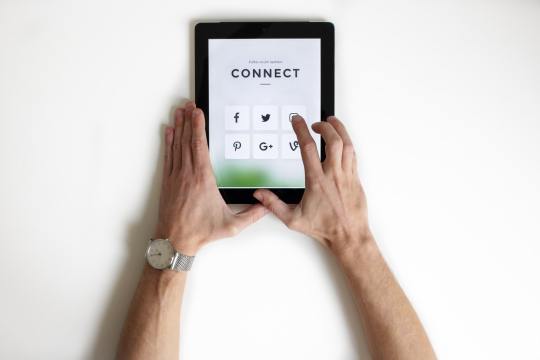
REFERENCES Buzzz Social Media 2011, The Social Media Revolution 2014, 23 October, viewed 8 April 2018, <https://www.youtube.com/watch?v=0eUeL3n7fDs>.
CNN, 2018, What you should know about the March for Our Lives, 23 March, viewed 13 April 2018, <https://edition.cnn.com/2018/03/21/us/march-for-our-lives-explainer/index.html>. C-SPAN 2012, Robert Putnam - Bowling Alone, 19 December, viewed 8 April 2018, <http://www.c-span.org/video/?c4236758/robert-putnam-bowling-alone>. HootSuite 2017, New research reveals global social media use increased by 21 percent in 2016, Hootsuite, viewed 11 April 2018, <https://hootsuite.com/it/newsroom/press-releases/digital-in-2017-report>.
Infoplease 2017, Timeline: Social Media, 2000-2017, viewed 13 April 2018, <https://www.infoplease.com/science/timeline-social-media/>.
TED-Ed 2013, Connected, but alone?- Sherry Turkle, 19 April, viewed 13 April 2018, <https://www.youtube.com/watch?v=rv0g8TsnA6c>. Universities Australia 2017, Higher education and research facts and figures, 27 March, viewed 13 April 2018, <https://www.universitiesaustralia.edu.au/australias-universities/key-facts-and-data#.WtChYSiFOV4>.
<!-- @page { margin: 2cm } P { margin-bottom: 0.21cm } A:link { so-language: zxx } -->
11 notes
·
View notes
